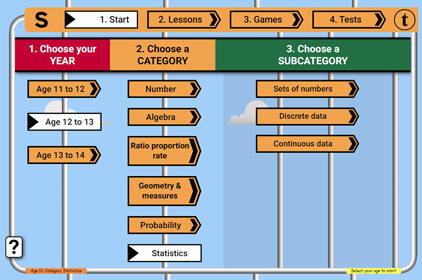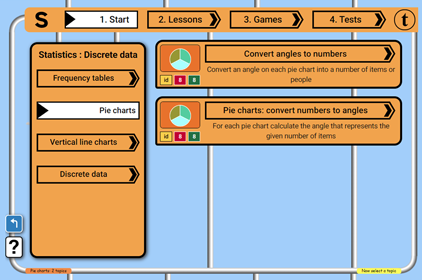


6th grade Ratio proportion rate topics for Secondary math learners
| Topic icon key | ||
eq | Equation | Each item in the topic is in the form of an equation |
id | Identify | Each item in the topic is a thing |
mi | Missing item | Each item in the topic is a statement with a missing term |
10 | Number of items | There are 10 items in this topic |
8 | Extended items | Additional questions for games and tests in this topic |
Our math topics for 6th grade learners are designed to follow closely the Common Core standards for math for 6th grade pupils.
Ratio proportion rate syllabus for 6th grade
Here are some key aspects of the math curriculum for ratio, proportion and rate for students aged 11 to 12:
Introduction to Ratios: Students are introduced to the concept of ratios, which represent the relationship between two quantities. They learn to express ratios using different formats, such as fraction notation, decimal notation, or the "to" or ":" symbol.
Equivalent Ratios: Students explore the idea of equivalent ratios, understanding that different ratios can represent the same relationship between quantities. They learn to simplify and scale ratios by dividing or multiplying both parts of the ratio by the same number.
Solving Ratio Problems: Students learn to solve various types of problems involving ratios. This includes finding missing values in a ratio, comparing ratios, and using ratios to solve real-world problems, such as scaling recipes or determining the dimensions of shapes.
Proportions: Students delve into proportions, which are equations that express equivalent ratios. They learn to set up and solve proportions in various contexts, such as solving for an unknown value in a proportion or using proportions to solve problems involving similar figures.
Rates: Students study rates, which involve the comparison of two different quantities with different units. They learn to calculate rates by dividing quantities, interpret rates in context, and solve problems involving rates, such as speed, unit price, or unit rates.
Solving Problems with Ratios, Proportions, and Rates: Students apply their understanding of ratios, proportions, and rates to solve more complex problems. These problems may involve multiple steps, require critical thinking and reasoning skills, and relate to real-life situations.
Visualization and Representation: Students develop skills in visualizing and representing ratios, proportions, and rates using diagrams, tables, graphs, and other visual models. They learn to interpret and create visual representations to enhance their understanding of these concepts.
Throughout the curriculum, students are encouraged to engage in problem-solving activities, collaborative discussions, and hands-on experiences to deepen their understanding of ratios, proportions, and rates. They also develop their mathematical reasoning, critical thinking, and communication skills as they explore these concepts.
A topic is selected at the beginning of a session at Free Math Games and will be remembered when you move between games or activities. The math for the topic is carefully constructed to match the level of difficulty taught in US schools. This means that you as a secondary pupil should see similar math problems to those you are seeing at school (if you are at school) for any particular subject. Please let us know if that is not the case.
See the help box below for instructions on choosing a topic here at Free Math Games.
UXO * Duck shoot * The frog flies * Pong * Cat and mouse * The beetle and the bee
Rock fall * Four in a row * Sow grow * Choose or lose * Mix and match





How to choose a 6th grade Ratio proportion rate topic for Secondary math

Click on the "1. Start" button in the top navigation bar - that brings you to this Secondary level topic selection page. On the topic selection page you will see that the topics are divided up:
- By level (Preschool, Elementary and Secondary)
- By grade (6th to 8th for this level)
- Into broad categories
Since you are currently within the Secondary section of Free Math Games you will see the Secondary topics. The Secondary grades will have loaded. Choose your grade. The broad categories available will load. Click on a category to see the available sub-categories and topics.

For example, if you choose 7th grade, then the category: "Algebra" and the sub-category "Sequences" you will be offered a choice of sub-sub-categories and topics suitable for your school grade - in the case of this example, "Generating terms" and "nth term expressions". Click on each sub-sub-category to view the available topics.
When you click on the name of a topic, the topic will load into the lesson page (once a topic has loaded it will be available for all activities and will not have to be downloaded again) and the lesson start page will be displayed. You can choose to do the lesson or jump immediately to the games using that topic.










